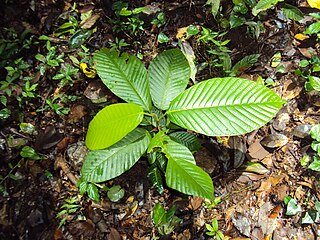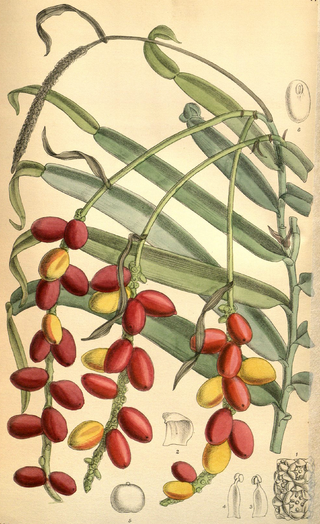
Antidesma is a genus of tropical plant in the family Phyllanthaceae formally described by Linnaeus in 1753. It is native to tropical Africa, S + E + SE Asia, Australia, and various oceanic islands. The greatest diversity occurs in Southeast Asia.

Dipterocarpus is a genus of flowering plants and the type genus of family Dipterocarpaceae.

Daemonorops was a genus of rattan palms in the family Arecaceae. Its species are now included within the genus Calamus.

Phoebe is a genus of evergreen trees and shrubs belonging to the Laurel family, Lauraceae. There are 75 accepted species in the genus, distributed in tropical and subtropical Asia and New Guinea. 35 species occur in China, of which 27 are endemic. The first description of the genus was of the type species P. lanceolata made in 1836 by Christian Gottfried Daniel Nees von Esenbeck in Systema Laurinarum, p. 98.

Arenga is a genus of palms, native to Southeast Asia, southern China, New Guinea, and northern Australia. They are small to medium-sized palms, growing to 2–20 m tall, with pinnate leaves 2–12 m long. Arenga palms can grow in areas with little sunlight and relatively infertile soil.

Chionanthus, common name: fringetrees, is a genus of about 150 species of flowering plants in the family Oleaceae.

Actinodaphne is an Asian genus of flowering plants in the laurel family (Lauraceae). It contains approximately 125 species of dioecious evergreen trees and shrubs.

Pothos is a genus of flowering plants in the family Araceae. It is native to China, the Indian Subcontinent, Australia, New Guinea, Southeast Asia, and various islands of the Pacific and Indian Oceans.

Barringtonia is a genus of flowering plants in the family Lecythidaceae first described as a genus with this name in 1775. It is native to Africa, southern Asia, Australia, and various islands of the Pacific and Indian Oceans. The genus name commemorates Daines Barrington.

Pholidocarpus is a genus of flowering plants in the family Arecaceae, native to Southeast Asia.

Plectocomia is a genus of flowering plant in the family Arecaceae native to China, the Himalayas, and Southeast Asia. Plants are dioecious, with male and female flowers produced on separate individuals.
Nothaphoebe is a genus of plant in family Lauraceae. It contains 21 species, which range from mainland Southeast Asia through Indonesia and the Philippines to New Guinea.
Prunus arborea is a species of plant in the family Rosaceae. It is found in Indonesia, Malaysia, Singapore, and Thailand.

Anisoptera is a genus of plants in the family Dipterocarpaceae. It contains ten species distributed from Chittagong in southeast of Bangladesh to New Guinea.
Nenga is a monoecious genus of flowering plant in the palm family. It is native to Southeast Asia and commonly called pinang palm. The genus name is based on a corruption of a Javanese term for a plant now classified within Pinanga.

Sciaphila is a genus of mycoheterotrophic plants in the family Triuridaceae. These plants receive nutrition from fungi and neighboring trees and have less need for photosynthesis. It is widespread in tropical and subtropical regions, found in Africa, China, Japan, the Indian Subcontinent, Southeast Asia, Latin America and on various islands Pacific Islands. The most noteworthy feature of the genus is the number of the various flower parts 99.9 percent of Monocots are trimerous, but Sciaphila spp. can have eight or even ten parts in a whorl.

Phrynium is a genus of flowering plants native to China, India, Southeast Asia, New Guinea and Melanesia. It was described as a genus in 1797.

Hornstedtia is a genus of plants in the Zingiberaceae. It is native to Southeast Asia, the Himalayas, southern China, New Guinea, Melanesia and Queensland.

Pachycentria is a genus of epiphytic or terrestrial shrubs that grow up to 2.5 m tall, or rarely small trees up to 8 m tall, indigenous to Burma, Thailand, Peninsular Malaysia, Sumatra, Java, Borneo, Philippines, Sulawesi, and New Guinea.
















